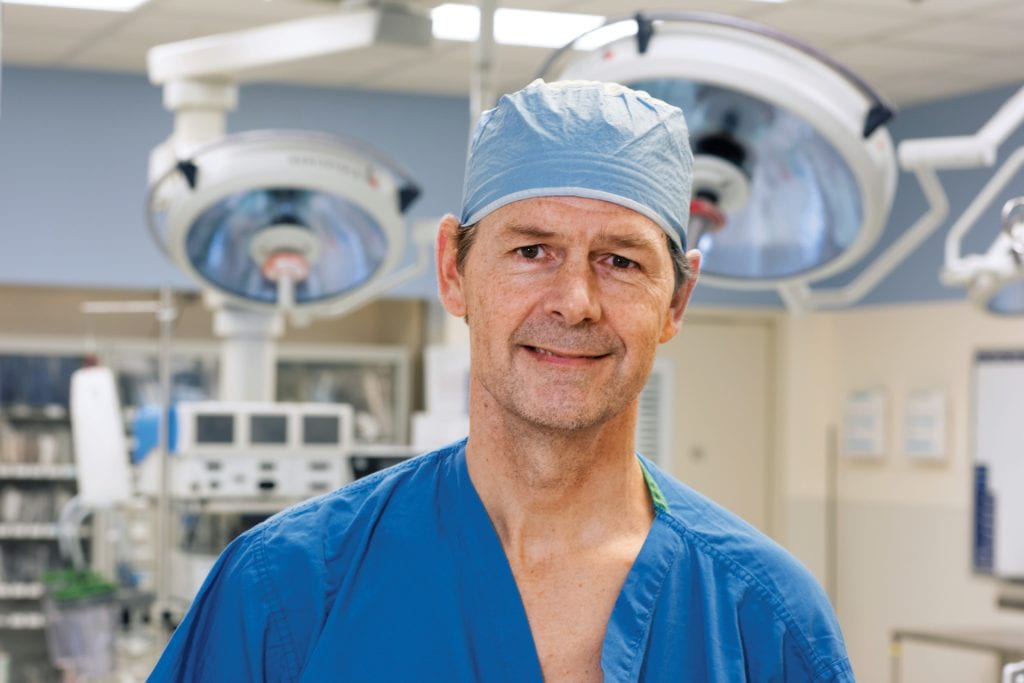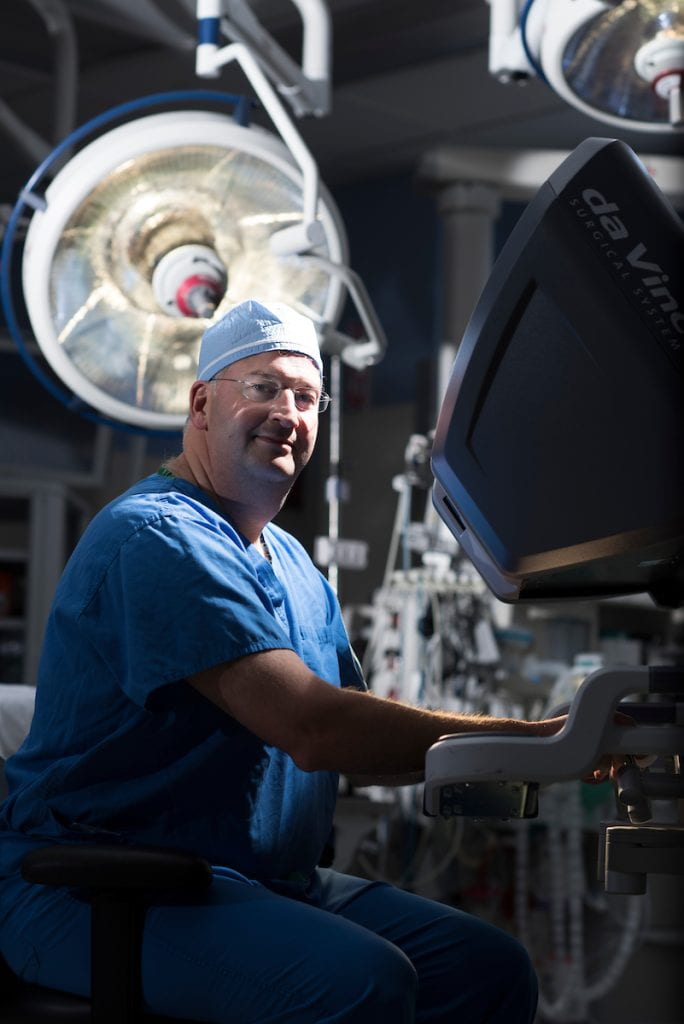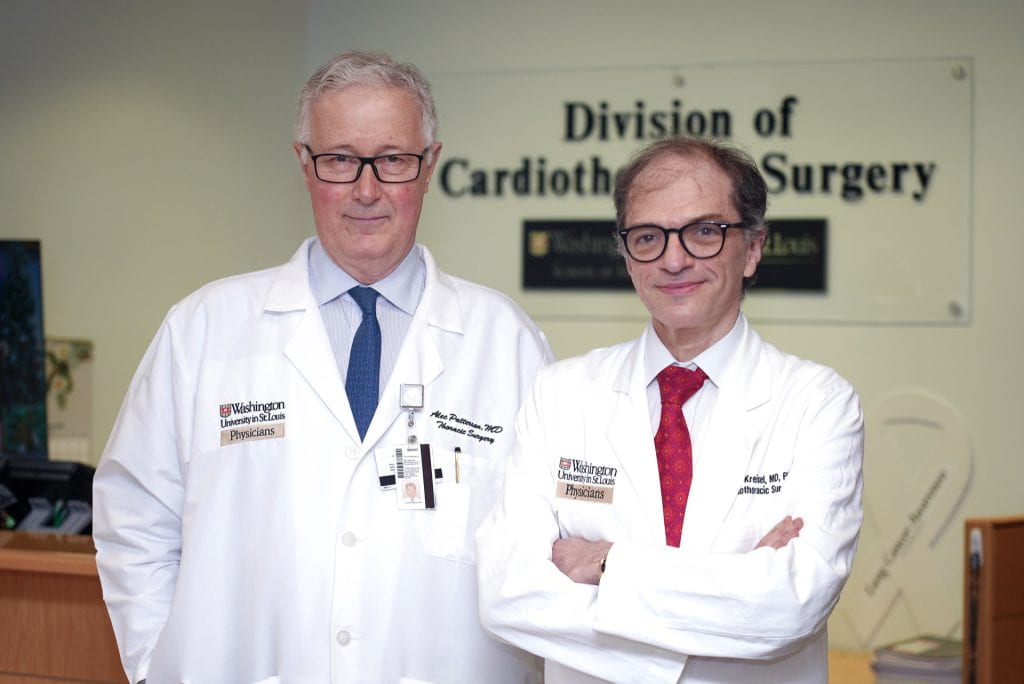The board-certified, internationally recognized thoracic surgeons at Washington University provide leading-edge respiratory medical and critical care, research and training. They offer a multitude of comprehensive treatments including airway surgery, procedures for benign esophageal disease, esophageal and lung cancer surgery, and lung transplantation. Many procedures are performed through minimally invasive techniques, including robotically assisted thoracic surgery. Since 1988, the lung transplant program at Barnes-Jewish Hospital has consistently led the country in the advancement of transplant science and remains as one of the most active transplant centers in the world. These surgeons also foster ongoing excellence in the next generation of thoracic surgeons through advanced fellowship training.
Highlights
Clinical

During two consecutive cycles, Washington University thoracic surgeons at Barnes-Jewish Hospital have received the highest overall rating in esophagectomy from the Society of Thoracic Surgeons. This score, which measures both absence of operative mortality and major morbidity, recognizes Washington University thoracic surgeons for their excellent performance in this rare procedure. Patients from across the region travel to Barnes-Jewish Hospital for this specialized treatment. “There are not many surgeons in Missouri or southern Illinois who can care for these patients because of the complexity of the problem,” says Bryan Meyers, MD, MPH, chief of thoracic surgery. “This grade is a clear validation of our success as a team.”
Research

Thoracic surgeons Varun Puri, MD, MSCI, and Benjamin Kozower, MD, MPH, are leading studies to improve treatment strategies for patients with lung cancer. Puri is PI of a study examining retrospective and prospective Veterans Health Administration data to describe and define the hallmarks of high-quality operations and outcomes in lung cancer care. Additionally, Kozower, Puri and a team of radiation oncologists and public health experts lead a multicenter trial comparing surgery and radiation therapy for stage I lung cancer. This NCI R01 project aims to develop and compare prediction models for lung cancer treatment outcomes and create a benchmark for personalized treatment through multidisciplinary collaboration.
Education

A study within the expanding portfolio of Thoracic Research Fellow Hailey Shepherd, MD, earned the Nicholas T. Kouchoukos Research Award following the second annual Kouchoukos Research Day presentations. The project, “Mechanisms Contributing to the Development of Pleural Fibrosis Following Pulmonary Transplantation,” was conducted alongside her mentor, Daniel Kreisel, MD, PhD, who is the G. Alexander Patterson, MD/Mid-America Transplant Endowed Distinguished Chair in Lung Transplantation. The project’s findings illustrated that hyaluronic acid accumulates in grafts quickly after transplantation, which may lead to notable fibrotic remodeling and irreversible injury to the lung. By identifying these mechanisms, research teams like Shepherd and Kreisel can explore potential treatments that inhibit them from damaging lung allografts after transplantation.

Leadership in Lung Transplantation
In 1988, Joel Cooper, MD, a surgical innovator in the development of single- and double-lung transplants, arrived at Washington University School of Medicine to lead the Section of Thoracic Surgery. Three years later, Cooper recruited one of his frequent collaborators and trusted colleagues, G. Alexander Patterson, MD, Joseph Bancroft Professor of Surgery, to direct Barnes-Jewish Hospital’s new lung transplantation program, marking the dawn of a new age of thoracic surgery excellence in our institution. Since Patterson’s arrival and the program’s inception, it has become one of the nation’s most recognized programs—both for successful patient outcomes and lower wait times—and has surpassed 1,900 lung transplants.
“WashU was one of the early centers of pioneering lung transplantations when Dr. Patterson and Dr. Cooper began performing transplants here in the late 1980s and early 1990s,” says Thoracic Surgery Section Chief and Patrick and Joy Williamson Professor of Surgery Bryan Meyers, MD, MPH.
With the section’s history of surgical innovation in the areas of lung transplantation at its core, the current thoracic surgery faculty are hard at work in maintaining its reputation for success and making new breakthroughs in the world of clinical and translational lung transplantation research.
Acquiring quality donor grafts has been a struggle for nearly all transplant centers across the world. Varun Puri, MD, MSCI, professor of surgery, is hard at work producing and validating predictive models that may help clinicians assess for quality lungs in brain dead donors. Additionally, Puri will also aggregate databases featuring the impact of donor factors on early outcomes in lung transplant recipients with the predictive models to allow clinicians to easily determine if donor lungs can be accepted and if they will function adequately after transplant.
Daniel Kreisel, MD, PhD, the current surgical director of the lung transplant program at Barnes-Jewish, Andrew Gelman, PhD, and Pulmonary & Critical Care Professor Ramsey Hachem, MD, are working to meet an unmet need to improve patient survival after lung transplant. In a pharmacological clinical trial, the trio will study a novel anti-inflammatory and immunosuppressive therapy called clazakizumab, and they predict it will help improve patient survival outcomes and reduce morbidity after transplantation.
Kreisel, Gelman and Research Associate Professor WenJun Li, MD, continue their ongoing PO1 research study into immune factors that affect graft survival in lung transplants.
“This project at the pathways regulating lung transplant tolerance, which is the opposite of resistance,” says Meyers. “From their collective research, they hope to determine how to ‘trick’ a host into accepting a transplant organ that the body sees as the same as itself so it doesn’t reject.”

Robot Ready
On Dec. 1, 2021, thoracic surgeons Varun Puri, MD, MSCI, Nabil Munfakh, MD, and their operative staff carried out the 500th robotic thoracic surgery at Christian Hospital in north St. Louis. This marked a major milestone for the Washington University thoracic robotic surgery program, which has continued to grow significantly in both clinical volume and training practices since its establishment.
From the program’s early success at Christian Hospital, Benjamin Kozower, MD, MPH, professor of surgery, has helped to establish a successful robotic practice at Barnes-Jewish Hospital.
“What we’ve seen is a significant growth in our robotic practice in recent years,” says Bryan Meyers, MD, PMH, Patrick and Joy Williamson Professor of Surgery. “Dr. Puri and Dr. Kozower lead the way in building this practice. In more recent years, Dr. Ray and I have also become active in robotic surgery.”
Shuddhadeb Ray, MD, MPHS, a former trainee of the robotic surgery program, is now a key member of the team at Christian Hospital. His expertise in minimally invasive procedures has contributed greatly to the growth of the program and the quality of training offered.
Minimally invasive robotic surgery has potential to become the gold standard of care when it comes to many thoracic procedures. In offering future surgeons opportunities to train alongside experts in this practice, the program has major influence on the next generation of leaders in thoracic surgery. “This area of our practice has reached a critical mass so that we see our trainees leave with a very firm grounding in robotic skills,” says Meyers. “They are ready to hit the ground running with robotic pulmonary resections and robotic benign esophageal surgery.”
The number of robotic cases at Christian Hospital and Barnes-Jewish Hospital has only been growing over the past several years, and that trend is projected to continue its growth in coming years.
“Our recent trainees have all completed the program ‘robot-ready,’” says Meyers. The trainees undergoing this invaluable experience with minimally invasive robotic technology and techniques early on in their careers have the opportunity to change the very face of thoracic surgery.

Identifying Causes of Vascular Damage in Lung Transplantation
A new study led by investigators in the Thoracic Immunology Laboratory at Washington University School of Medicine has identified triggers that cause tissue damage in donor lungs during reperfusion.
“We found that there is substantially more infiltration of neutrophils in the lungs when lungs are subjected to a period of warm ischemia. These neutrophils are attracted to certain vessels, which they destroy on their way into the air spaces. This process is associated with substantial damage to the donor lungs. We were able to describe the individual steps that guide the neutrophils into the lungs during this process,” says first author Wenjun Li, MD.
The investigators described that necroptosis triggered recruitment of neutrophils. “The damage caused by necroptosis releases damage-associated molecular patterns, which engage receptors on the cells in the lungs, including nonclassical monocytes and vascular endothelial cells. These nonclassical monocytes secrete chemokines, which bring neutrophils into the vessels. Think of chemokines as the immune system’s breadcrumbs. Neutrophils follow these breadcrumbs to the vessels, where they cause sterile inflammation. The neutrophils destroy the vessel wall and lead to lung graft dysfunction,” says study senior author Daniel Kreisel, MD, PhD, the inaugural G. Alexander Patterson, MD/Mid-America Transplant Endowed Distinguished Chair in Lung Transplantation.
Kreisel, a professor of surgery, pathology and immunology, and Li, an associate professor of surgery, used intravital imaging to observe how the immune system responds to lung transplantation in real time. This technique makes it possible to see how living cells behave in their natural environment. Such contributions have advanced the scientific understanding of immune responses to transplantation for researchers around the globe.
One key finding from this study is that the lungs are damaged through a different process than other organs. In 2019, Li published a study describing ferroptosis, the inflammatory cell death pathway affecting donor hearts. This type of cell death differs from the necroptosis in transplanted lungs described in the PNAS study.
“Tailoring future pharmacological therapies for each organ could prevent inflammatory responses in transplanted organs, meaning a reduced risk of ischemia-reperfusion injury and primary graft dysfunction,” says Kreisel.
“One take-home message of this study is that each organ has its own intricacies in terms of immune response and cell death pathways,” Kreisel says. “Therapies need to be tailored so that we treat lung transplantation with different drugs than other organs.”